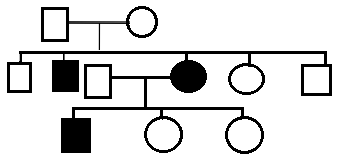#27-Pedigree-Analysis-Problem-Solving
(Botany) > Principles of Inheritance & Variation
My Notes
Create your notes while watching video by clicking on icon in video player.
Related Practice Questions :
Study the pedigree chart given below

What does it show?
| 1. | Inheritance of a sex-linked inborn error of metabolism like phenylketonuria |
| 2. | Inheritance of a condition like phenylketonuria as an autosomal recessive trait |
| 3. | The pedigree chart is wrong as this is not possible |
| 4. | Inheritance of a recessive sex-linked disease like haemophilia |
71%
Level 2: 60%+
NEET - 2009
Hints
Given below is a pedigree chart of a family with five children. It shows the inheritance of attached ear-lobes as opposed to the free ones. The squares represent the male individuals and circles the females individuals. Which one of the foloowing conclusions drawn is correct?
(1) The parents are homozygous recessive.
(2) The trait is Y-linked.
(3) The parents are homozygous dominant.
(4) The parents are heterozygous.
64%
Level 2: 60%+
AIIMS - 2004
Hints




